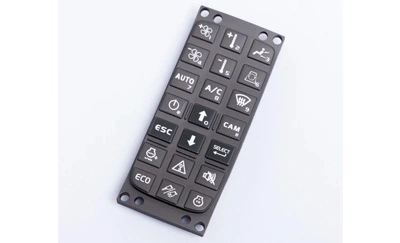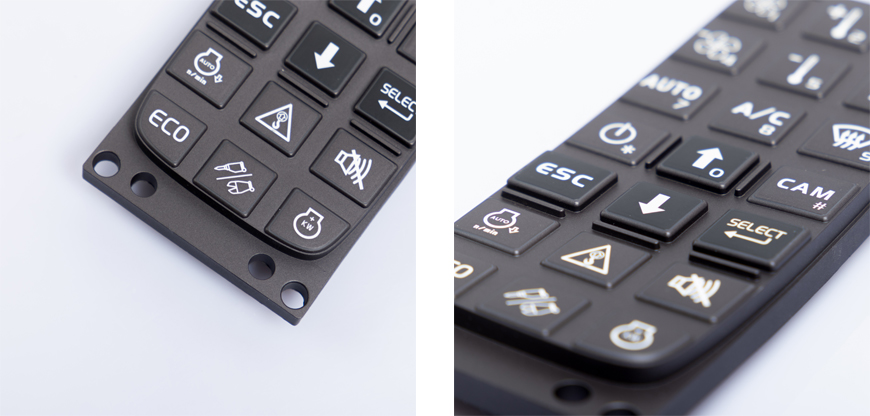
In today's fast-paced technological landscape, user interface design has become a critical element in the success of electronic devices. One of the most innovative and versatile solutions in this realm is the Matrix Membrane Switch Keypad. In this comprehensive guide, we will explore the ins and outs of Matrix Membrane Switch Keypads, their applications, advantages, and much more. Join us on this journey as we dive deep into the world of cutting-edge user interfaces.

Matrix Membrane Switch Keypads have revolutionized the way we interact with electronic devices. These advanced user interfaces offer exceptional versatility, durability, and customization options, making them an ideal choice for various industries. In this article, we will provide a comprehensive overview of Matrix Membrane Switch Keypads, their working principles, applications, and the advantages they bring to the table.
A Matrix Membrane Switch Keypad is a user interface that consists of multiple layers of flexible materials. These layers include a top graphic overlay with printed symbols, spacer layers, and conductive layers. When pressure is applied to a specific area on the keypad, it forms an electrical connection between the conductive layers, registering a keypress.
Matrix Membrane Switches operate on the principle of a matrix grid. When a user presses a key on the keypad, it pushes the top layer down, causing the conductive layers to come into contact at the intersection of the grid. This contact generates an electrical signal that corresponds to the pressed key, allowing the device to recognize and respond to the input.
Matrix Membrane Switch Keypads find applications across various industries due to their versatility and reliability.
Industrial control panels often require rugged and durable user interfaces. Matrix Membrane Switch Keypads are an excellent choice for such applications, as they can withstand harsh environments, including exposure to dust, moisture, and chemicals.
In the medical field, hygiene and ease of cleaning are essential. Matrix Membrane Switches can be sealed to prevent the ingress of liquids and contaminants, making them suitable for medical devices such as diagnostic equipment and patient monitoring systems.
Many consumer electronics, such as microwave ovens and remote controls, utilize Matrix Membrane Switch Keypads for their sleek and compact design. They provide a tactile feedback that enhances the user experience.
Matrix Membrane Switch Keypads are also found in various automotive applications, including dashboard controls, infotainment systems, and climate control panels. Their durability and resistance to environmental factors make them a reliable choice for the automotive industry.
Matrix Membrane Switches offer several advantages that make them stand out as a preferred choice for user interfaces:
Durability: These keypads can endure millions of actuations, ensuring long-lasting performance.
Customization: Manufacturers can easily customize the appearance and layout of the keypad to meet specific design requirements.
Cost-Effective: Matrix Membrane Switches are cost-effective compared to other interface options.
Tactile Feedback: Users appreciate the tactile feedback provided by these keypads, enhancing the overall user experience.
Manufacturers can tailor Matrix Membrane Switch Keypads to their exact needs. This includes choosing the type of graphic overlay, the arrangement of keys, and the integration of additional features such as backlighting and tactile feedback.
Matrix Membrane Switch Keypads are built to last. Their robust construction ensures resistance to wear and tear, making them an excellent choice for applications where reliability is paramount.
Maintaining Matrix Membrane Switches is relatively straightforward. Regular cleaning with a mild solution and a soft cloth can help prolong their lifespan. Avoid using abrasive materials or harsh chemicals that could damage the keypad.
Matrix Membrane Switch Keypads have their unique advantages, but it's essential to understand how they compare to other user interfaces.
Mechanical keyboards offer a different typing experience with distinct tactile feedback. However, they can be noisier and bulkier than Matrix Membrane Switches.
Capacitive touchscreens provide a smooth and intuitive user experience but may not be suitable for all environments. They can be less durable in harsh conditions.
Rubber keyboards are known for their flexibility and waterproof properties. However, they may not offer the same level of customization as Matrix Membrane Switch Keypads.
As technology continues to evolve, Matrix Membrane Switches are expected to follow suit. Future trends may include thinner and more flexible keypads, advanced haptic feedback, and improved resistance to extreme conditions.
Matrix Membrane Switch Keypads have become an integral part of modern electronic devices, offering durability, customization, and tactile feedback. Their applications span across industries, making them a versatile choice for user interface design. As technology advances, we can expect even more innovations in this field.
Can Matrix Membrane Switch Keypads be used in outdoor applications?
Yes, Matrix Membrane Switch Keypads can be sealed to withstand outdoor conditions, making them suitable for various outdoor applications.
Are Matrix Membrane Switch Keypads resistant to chemicals?
Yes, they can be designed to resist exposure to a wide range of chemicals, making them suitable for use in environments where chemical resistance is crucial.
Can I customize the appearance of a Matrix Membrane Switch Keypad for my product?
Absolutely! Matrix Membrane Switch Keypads offer extensive customization options, allowing you to tailor the keypad's appearance to match your product's design.
How long do Matrix Membrane Switch Keypads typically last?
These keypads are designed for longevity and can endure millions of actuations, ensuring a long lifespan for your product.
Are Matrix Membrane Switch Keypads cost-effective for mass production?
Yes, they are a cost-effective choice for mass production due to their efficient manufacturing processes.